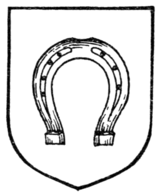the comprehension of most people; at any rate heraldry knows of none.
The crest of the family of Duncombe is curious, and is as follows: "Out of a ducal coronet or, a horse's hind-leg sable, the shoe argent."
Though they can hardly be termed animate charges, perhaps one may be justified in here mentioning the horse-shoe (Fig. 363), which is far from being an uncommon charge. It will be found in various arms for the name of Ferrar, Ferrers, Farrer, and Marshall; and, in the arms of one Scottish family of Smith, three horse-shoes interlaced together form an unusual and rather a curious charge.
Other instances in which it occurs will be found in the arms of Burlton, and in the arms used by the town of Oakham. In the latter case it doubtless has reference to the toll of a horse-shoe, which the town collects from every peer or member of the Royal Family who passes through its limits. The collection of these, which are usually of silver, and are carefully preserved, is one of the features of the town.
 Fig. 363.—Horse-shoe. |
 Fig. 364.—Sea-horse. |
 Fig. 365.—Pegasus rampant. |
The sea-horse, the unicorn, and the pegasus may perhaps be more properly considered as mythical animals, and the unicorn will, of course, be treated under that heading; but the sea-horse and the pegasus are so closely allied in form to the natural animal that perhaps it will be simpler to treat of them in this chapter. The sea-horse (Fig. 364) is composed of the head and neck of a horse and the tail of a fish, but in place of the fore-feet, webbed paws are usually substituted. Two sea-horses respecting each other will be found in the coat of arms of Pirrie, and sea-horses naiant will be found in the arms of M‘Cammond. It is a matter largely left to the discretion of the artist, but the sea-horse will be found as often as not depicted with a fin at the back of its neck in place of a mane. A sea-horse as a crest will be found in the case of Belfast and in the crests of Clippingdale and Jenkinson. The sea-horse is sometimes represented winged, but I know of no officially sanctioned example. When represented rising from the sea the animal is said to be "assurgeant."
